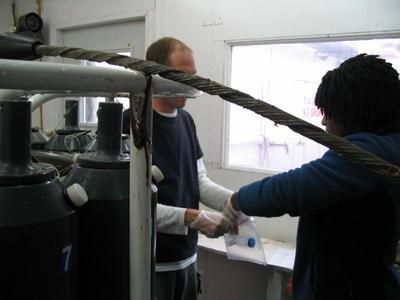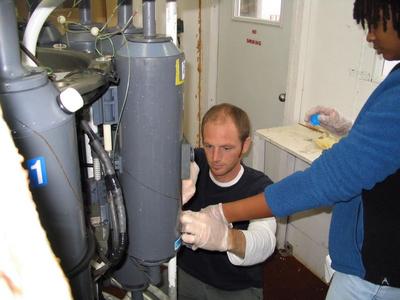
|
|
16 July, 2004
So much for writing a little about the ship each day! I'll be lucky to get
my science journals and photos posted. Now that our work has started, the
stations come very quickly, one after the other. We wrapped up our first
two on this line at around 7 last night; I finished my journals and got to
bed around 9. We got up again at 1:30 AM because they had not found the
mooring (they will look again in the fall), and started our third station.
We finished that one at 3:45, I got a little sleep until 6:00, and we
finished our second station around 9. I'll probably stay up now until 11 AM
when we'll do our last station on this line. I hope to get someone to take
pictures for me during that station, so I'll have some to post tomorrow.
For now, let me tell you about Bryan Page's work.
Bryan is a Master's student in environmental chemistry at the University of
Manitoba. This is his first trip to the Arctic. Bryan is looking at trace
element cycling, parcticularly mercury. Because it's extremely easy to
contaminate samples (breathing on the bottle, or touching it, can ruin a
sample), his collection technique is very exact. When taking water from the
CTD bottles, he uses the "clean hands, dirty hands" technique. The "dirty
hands" person opens the first Ziploc bag and turns the water spout on and
off. The "clean hands" person then opens the second Ziploc bag and the
collection bottle. Bryan then reverses the process once the sample has been
collected. Once we leave the ship, he will take his samples back to UCTEL,
the Ultra Clean Trace Element Laboratory, at the University of Manitoba.
This is a completely metal free lab with an airlock and three clean rooms,
each one cleaner than the one before. The bottle is only opened in the last
room.
Mercury is everywhere as a trace element, but scientists have recently seen
a significant increase in the amounts of mercury found in the livers of
beluga whales (the white whales found at northern latitudes) despite a
decrease in atmospheric emissions of mercury from human activity. Mercury
is naturally released from volcanoes and given off from soils and water.
Human sources of mercury include such things as waste incinerators, coal
fired power plants, and fossil fuel combustion in general. Since human
caused emissions have decreased, the question is where is this mercury
coming from that is accumulating in the beluga whales? One hypothesis is
that it's related to global climate change and a shift between sources and
"sinks" (areas that remove mercury from the atmosphere.) Traditionally, ice
and permafrost have acted as sinks for the mercury but, as the ice and
permafrost melt, they may have become sources. As the permafrost melts,
more water travels through it possibly causing greater movement of elements.
Bryan is testing now in the Bering Strait, while other members of his team
have tested in the McKenzie River, the Beaufort Sea (of the Arctic Ocean),
and Hudson's Bay.
While on deck today, we had two very unusual sightings - a lone seal and the
sun! Both sightings lasted less than a minute.

Bryan ("clean hands") and Alicia ("dirty hands") collecting the water sample. --

Bryan Page collecting water for analysis of the trace element mercury. --
Contact the TEA in the field at
.
If you cannot connect through your browser, copy the
TEA's e-mail address in the "To:" line of
your favorite e-mail package.
|
